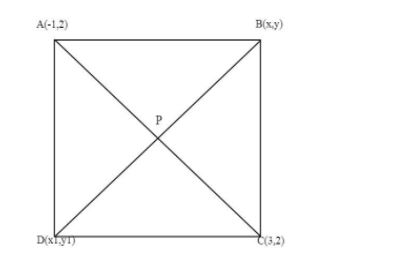Question
Question: The two opposite vertices of a square are (−1,2) and (3,2). Find the coordinates of the other two ve...
The two opposite vertices of a square are (−1,2) and (3,2). Find the coordinates of the other two vertices.
Solution
In this particular type of question firstly we need to find the value of x using distance formula (distance between (x1,y1) and (x2,y2) = (x1−y1)2+(x2−y2)2) in AB and BC. Then we need to proceed by using Pythagoras theorem in △ABC and find the values of y to get the coordinates of opposite vertices of the square.
Complete step-by-step answer:

Let ABCD is a square where two opposite vertices are A(−1,2) and C(3,2).
Let B(x,y) and D(x1,y1) be the other two vertices.
In Square ABCD
AB=BC=CD=DA
Hence AB=BC
(x+1)2+(y−2)2=(3−x)2+(2−y)2 (by distance formula)
Squaring both sides
⇒(x+1)2+(y−2)2=(3−x)2+(2−y)2 ⇒x2+1+2x+y2+4−4y=9+x2−6x+4+y2−4y ⇒2x+5=13−6x ⇒2x+6x=13−5 ⇒8x=8 ⇒x=1
In △ABC, ∠B=90∘
(All angles of the square are 90∘)
Then according to the Pythagoras theorem
$
A{B^2} + B{C^2} = A{C^2} \\
\Rightarrow 2A{B^2} = A{C^2}{\text{ }}\left( {{\text{since AB = BC}}} \right) \\
\Rightarrow 2{\left( {\sqrt {{{\left( {x + 1} \right)}^2} + {{\left( {y - 2} \right)}^2}} } \right)^2} =
{\left( {\sqrt {{{\left( {3 - {{\left( { - 1} \right)}^2}} \right)}^2} + {{\left( {2 - 2} \right)}^2}} } \right)^2} \\
\Rightarrow 2\left( {{{\left( {x + 1} \right)}^2} + {{\left( {y - 2} \right)}^2}} \right) = {\left( {3 + 1} \right)^2} + {\left( {2 - 2} \right)^2} \\
\Rightarrow 2\left( {{x^2} + 2x + 1 + {y^2} + 4 - 4y} \right) = {4^2} \\
{\text{put x = 1}} \\
\Rightarrow {\text{2}}\left( {{1^2} + 2 + 1 + {y^2} + 4 - 4y} \right) = 16 \\
\Rightarrow 2\left( {{y^2} - 4y + 8} \right) = 16 \\
\Rightarrow 2{y^2} - 8y + 16 = 16 \\
\Rightarrow 2{y^2} - 8y = 0 \\
\Rightarrow 2y\left( {y - 4} \right) = 0 \\
y = 0,4 \\
$
Therefore the other two vertices of square ABCD are (1,0) and (1,4).
Note: Remember to recall the basic properties of square, Pythagoras theorem and distance formula while solving this type of question. Note that there are two values of y but only one of x, which means the opposite vertices B and D have the same coordinate of x but different coordinates of y. This question could also be solved by using △ACD and applying the distance formula and Pythagoras theorem in the same way.
